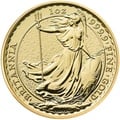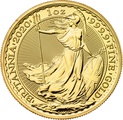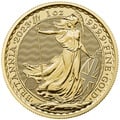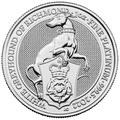One hundred pounds
There was a time when one hundred pounds was a considerable sum of money. Taking inflation into account, £100 in 1980 would be the equivalent of £482 today, and would have equalled a huge £12,000 based on the pound's value in 1900!
The value and spending power of £100 today compared to previous decades.
One hundred pound coin
There has been talk of introducing a one hundred pound coin for years but, so far, the Bank of England has refused to do this for common circulation currency that we use every day.
There are 'legal tender' £100 coins, but these are commemorative or bullion coins only, and are not considered circulating currency. In the UK, a one hundred pound coin will likely be made of gold, silver or platinum. They have a £100 face value but are, in reality, worth far more on account of their precious metal content. Coin collectors – or numismatists – may even pay an additional premium for specific examples. This means you would be ill-advised to try spending them in your local high street shop!
Precious metals in the form of bullion and commemorative coins offer tax advantages over bars of the same weight. A one hundred pound coin made of gold, silver or platinum will benefit from being exempt of CGT, as the face value of £100 classes them as legal tender. Gold bars and coins, unlike other precious metals, are also VAT-free. This makes £100 precious metal coins attractive to both investors and coin collectors alike.
£100 silver coins
Issued for the first time in 2015 (and sold at its face value) was the Big Ben silver £100 coin. It was designed by Glyn Davies and Laura Clancy. Only 50,000 were minted from .999 fine silver and all sold within just 11 days.
The Big Ben coin was quickly followed by the Buckingham Palace £100 coin, and Trafalgar Square £100 coin in 2016. These are now already changing hands for well over their face value.
£100 gold coins
There are many gold commemorative and bullion coins with a face value of £100. These include the gold Queen's Beasts series, gold Lunar New Year series and gold Royal Arms coins. The most popular, and best known £100 gold coin is the gold Britannia.
Gold Britannia
The gold Britannia was first minted in 1987 from 22 carat or 916.7 fineness gold. After 2013, it was minted from 24 carat or 999.9 fineness. All contain one ounce of pure gold, and we're classed as one hundred pound coins.
Depending on prices in the gold commodities market, Britannia coins can currently trade for around £1,300. Numismatic interest can push the price far higher for proof version, but the bullion coins are typically valued on metal content alone as an investment coin.
Smaller, fractional Britannia coins are also released regularly, with accordingly lower face values. In 2013 a larger £500 coin, containing five ounces of gold, was added to the range.
Gold Queen's Beasts
The gold
Queen's Beasts
series of coins also have a face value of £100. Silver Queen's Beasts are denominated at £5. The series will eventually feature 10 different beasts, all of which were present as statues outside of Westminster Abbey for the Queen's coronation in 1953. The first coin, featuring a lion, was minted in 2016. An 11th Completer coin was released to capstone the series. The Royal Mint have since moved onto the
Tudor Beasts
series.
Gold Royal Arms coins
The Royal Arms are a symbol of strength and represent the illustrious history of monarchy and heraldry in the United Kingdom. The Royal Mint has set a mint limit of 5,000 for these coins. The 2019 and 2020 Royal Arms 1oz Gold coin is then another attractive £100 coin option for investors and collectors.
Generally speaking, if The Royal Mint make a 1oz gold coin they will denominate at £100 per tradition. This means other series, such as the new Myths & Legends series, are also classed as one hundred pound coins. Despite their gold value being much higher it is likely The Royal Mint will continue this tradition for many years to come.
£100 platinum coins
The Royal Mint also strikes Britannia and Queen’s Beasts coins in platinum. These are denominated at £100, as are their gold equivalents. Platinum is growing in popularity as an investment metal, and is taxed similarly to silver; subject to VAT, but exempt from Capital Gains Tax when in the form of a one hundred pound coin.
- How To Buy Gold
- How to Buy?
- Payment Options
- Delivery Options
- Gold Storage
- Storage at Brink's
- Gold Investment Guide
- Why buy gold?
- Is gold a good investment?
- Why physical gold?
- Best time to buy gold?
- Gold bars vs coins?
- Gold vs Silver
- Gold - Silver Ratio explained
- VAT on bullion
- CGT on bullion
- Legal tender coins
- Top 5 Gold Investments
- Top 5 Silver Investments
- Gold vs ISAs
- Gold vs Buy-to-Let
- Gold vs FTSE 100
- Gold vs Bitcoin
- Where to buy gold?
- Why buy from us?
- Where to sell gold?
- Coin Shops
- Gold Price Forecasts
- Top 10 Gold Producers
- Top 10 Gold Reserves
- Gold Britannia vs Sovereign
- Britannia coin designs
- Sovereign coin designs
- Sovereign Mintages
- Sovereign mint marks
- British coin specs
- What is a proof coin?
- Royal Mint bullion
- The Queen's Beasts
- Royal Mint Lunar Coins
- Bullion Refiners
- British coin mints
- Krugerrands
- Gold Tola - India & Pakistan
- Bullion Index
















